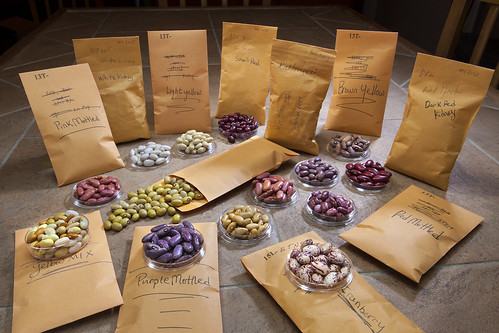
USDA-ARS maintains a collection of dry beans obtained from around the globe and catalogued for important traits, like resistance to diseases and pests. USDA-ARS photo by Steve Ausmus.
2016 has been named “International Year of the Pulses” by the General Assembly of the United Nations (UN). The goal of the initiative is to educate consumers about the nutritional and other benefits of eating pulse crops, as well as to marshal the capabilities of agricultural research organizations around the world in developing new, improved varieties that will help further global food security and sustainable agriculture.
Pulses refer to the dry edible seed of certain leguminous plants—most notably dry beans (like kidney, pinto and navy beans), dry peas, lentils and chickpeas.
Over the past 5 years, the Agricultural Research Service has appointed a special team of agency researchers to leverage its expertise and resources in support of the Feed the Future Grain Legume Project, a food security initiative of the U.S. Agency for International Development.
It’s a charge that often has them travelling to communities in parts of Sub-Saharan Africa, Central America and the Caribbean, where the challenges of growing pulse crops such as dry beans can be particularly daunting for rural and small-holdings farmers—especially against the likes of bean rust, angular leaf spot and other costly plant diseases.
Besides their robust flavor, diverse color and general heartiness, the UN’s Food and Agriculture Organization notes that “pulses are a vital source of plant-based proteins and amino acids for people around the globe and should be eaten as part of a healthy diet to address obesity, as well as to prevent and help manage chronic diseases such as diabetes, coronary conditions, and cancer; they are also an important source of plant-based protein for animals.”
ARS’s Feed the Future team—comprising Phil Miklas, Karen Cichy, Talo-Corrales, Tim Porch and Mike Grusak—has already made important inroads to helping ensure broader access to the very best that pulses have to offer—especially in regions where the crops are staple food sources.
Below is a mere snapshot of contributions to date:
- Andean Diversity Panel (ADP) —a collection of nearly 500 accessions of large-seeded dry beans of Andean descent obtained from more than a dozen countries and catalogued for important traits, like high mineral content, adaptability to nutrient-poor soils and resistance to diseases and pests.
- Discovery that certain genomic regions are responsible for “fast-cooking,” a valuable trait that can reduce the cooking time of beans—thus reducing the amount of fuel needed to prepare meals in resource-poor households.
- Breeding and pathology training to East African, Haitian and Central American scientists, particularly in developing locally adapted varieties that can withstand common bacterial blight, angular leaf spot and other bean diseases of concern.
2016 promises to be no less busy for ARS’s “bean team” and their Feed the Future partners—with benefits to consumers abroad and at home. For updates, visit their blog page athttp://arsftfbean.uprm.edu/bean/. You can also read more about their efforts in the February 2016 edition of AgResearch online.
No comments:
Post a Comment